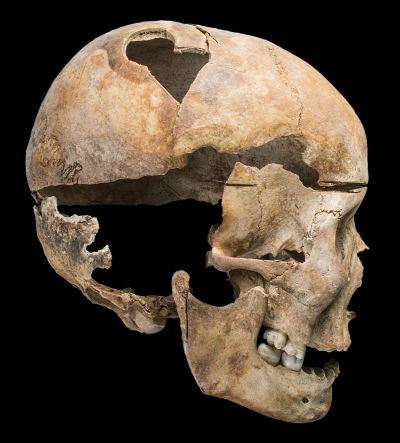Accidents, violence, gunshot wounds, amputations and disease: the brutal reality of the lives and deaths of 400 mainly local Oxfordshire people in the 18th and 19th centuries is outlined in a new book, based on Oxford Archaeology’s excavation of burials associated with Dr John Radcliffe’s Infirmary
The excavations in 2013 were at the site of the University of Oxford’s Blavatnik School of Government on Walton Street, then under construction, and revealed evidence of a range of injuries as well as early surgical experiments. Some of the remains date back more than 200 years and provide insight into hospital conditions in an era before anaesthesia, sterile operating theatres and antiseptics.
The results of the excavation and subsequent analysis are presented in The Patients’ Story: Dr Radcliffe’s Legacy in the Age of Hospitals. Excavations at the 18th-19th century Radcliffe Burial Ground, Oxford, which contains fascinating – and grim – details of the lives of poor and working class people who died while being treated at the Oxford hospital.
Accidents involving trains, threshing machines and printing machines were the most common, reflecting the influence of the railway, the printing press and farming.
But the biggest cause of death was shown to be infection. The Radcliffe burials were from a time when hospitals were breeding grounds for disease due to overcrowding and lack of sanitation. Infection was common on the excavated bones and included examples of tuberculosis, syphilis and possible leprosy. Although prevalent during the medieval period, by the 18th/19th century, leprosy had declined so it is rare to find it in archaeological skeletons from this period.
Surgery was focussed on procedures which were quick and non-invasive, most commonly, amputation. Examples of amputation were common among the excavated bones and most were isolated, sawn limbs – usually lower limbs, some with evidence of incurable trauma and/or infection. There were also skeletons with amputated limbs, but these were not many, reflecting that more individuals undergoing limb amputation at the hospital survived than died.
Evidence of a sacrectomy (removal of the base of the spine) was also found – a remarkable example of surgical intervention and possibly the earliest physical example to be discovered archaeologically. This type of operation may have been performed to remove a cancerous growth. An invasive and risky operation, it reflects advanced medical intervention for its time which would have required a level of detail and time that was beyond most 18th/19th century surgical ability.
Dr Louise Loe, senior osteologist at Oxford Archaeology and honorary research associate with Oxford University’s School of Archaeology, said:
‘It has been an enormous privilege to study these skeletons and we are very grateful for this opportunity. The great results were only possible due to very dedicated teams at Oxford University and Oxford Archaeology. The knowledge that we have gained of the hospital during its early years is immeasurable. Although a lot has been written about the early hospital, there has never, until now, been an opportunity to study the remains of the patients themselves and this is really rather special.’
Oxford Archaeology’s book is available from Oxbow Books. Click here for more details.
Story from Oxford Archaeogy News



